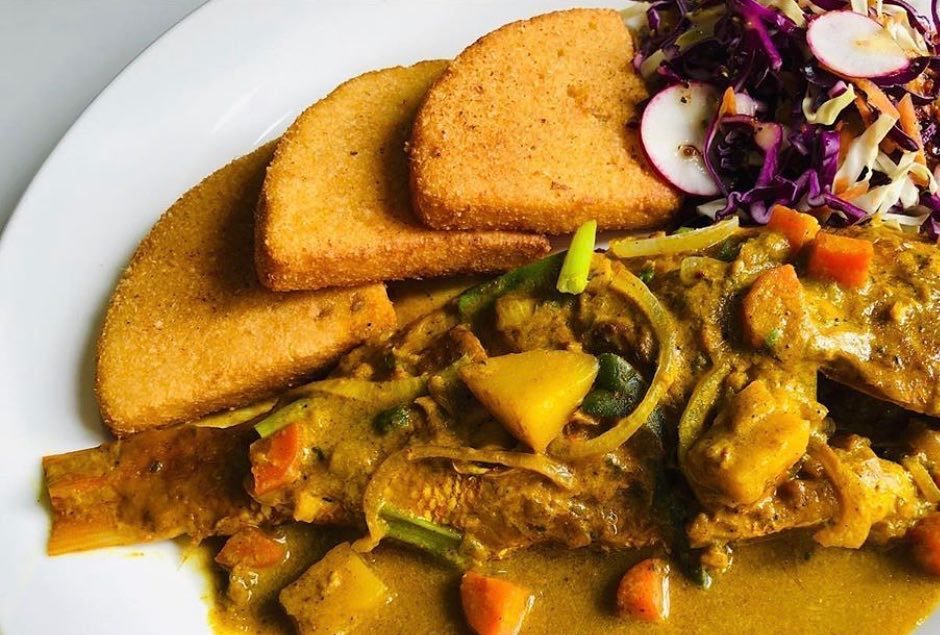As a food enthusiast with a passion for authentic flavors, I recently found myself craving a taste of the Caribbean. Fortunately, living in a vibrant community like Negril, Jamaica, means having access to the freshest local ingredients straight from the source. On a whim, I decided to celebrate my birthday by cooking up a storm in my kitchen, creating a dish that would transport me to the heart of the island’s rich culinary heritage.
Recreating the Magic at Home
For those eager to recreate this Jamaican culinary masterpiece in their own kitchens, I’ve included a detailed recipe card below. While the process may seem intricate, the rewards of this homemade coconut curry fish are well worth the effort. Embrace the art of slow cooking, allow the flavors to mingle, and savor each bite as a celebration of the vibrant culinary heritage of Jamaica.
Jamaican Coconut Curry Fish Recipe
Ingredients:
- 2 fresh whole snappers or any white fish fillets (cod, halibut, or tilapia)
- 2 whole scotch bonnet peppers, pierced to release flavor and heat
- 7 whole garlic cloves
- 2 tablespoons Jamaican curry powder
- 1/2 cup diced onion
- 1 cup sliced okra
- 2-3 sprigs fresh thyme
- 1 scallion, chopped
- 1-inch piece ginger, minced
- 1/2 cup fresh or canned coconut milk
- Coconut oil for frying
Instructions:
- Make 3 shallow cuts into each side of the fish fillets to allow the flavors to penetrate. Pat dry with paper towels and season with salt and pepper.
- In a large skillet or Dutch oven, heat coconut oil over medium heat until shimmering. Add 1 pierced scotch bonnet pepper and 6 whole garlic cloves. Cook for 1 minute to infuse the oil with their flavors.
- Increase the heat to medium-high and add the fish fillets. Sear on both sides until partially cooked, about 2-3 minutes per side. Remove the fish, garlic, and pepper from the pan and set aside.
- Discard half of the oil from the pan, then return it to low heat. Add the remaining garlic clove, diced onion, ginger, remaining scotch bonnet pepper, and curry powder. Cook until fragrant and the onions are softened, about 2-3 minutes.
- Pour in the coconut milk and simmer until the sauce has reduced and thickened slightly, about 5-7 minutes.
- Return the seared fish to the pan, along with the sliced okra, fresh thyme, scallions, and a pinch of salt. Gently spoon the sauce over the fish.
- Cover the pan and simmer on low heat for 45 minutes to 1 hour, turning the fish carefully every 15-20 minutes, until the fish is cooked through and flakes easily with a fork.
- Serve the coconut curry fish hot, garnished with fresh thyme and scallions, accompanied by basmati rice, garlic mashed potatoes, and a fresh beetroot salad.
Enjoy this authentic taste of Jamaica, where every bite tells a story of vibrant flavors, homemade traditions, and a culinary journey that celebrates the island’s rich heritage.
A Spontaneous Culinary Adventure
The day started with a spontaneous trip to the fishermen’s beach, where I handpicked two plump snappers straight off the boat. Breathing in the salty sea air, I could already envision the flavors these fresh catches would bring to my dish. With the main ingredient secured, I ventured into the lush coconut groves nearby, plucking a few ripe coconuts from the trees. Little did I know that this simple act would set the stage for a truly authentic Jamaican coconut curry fish experience.
The Essence of Homemade Coconut Milk
As I cracked open the coconuts, their creamy flesh revealed a treasure trove of natural flavors. Using a traditional grating technique, I extracted the fresh coconut milk, infusing it with the essence of the island. This homemade coconut milk would become the foundation of my curry, lending a rich, velvety texture and a subtle sweetness that would complement the spices and seafood perfectly.
A Medley of Spices and Flavors
With the coconut milk prepared, I turned my attention to the spice cabinet, assembling a vibrant array of aromatic ingredients. Jamaican curry powder, a blend of turmeric, cumin, coriander, and other exotic spices, would provide the base for the curry. Garlic cloves, ginger, and scotch bonnet peppers promised to add depth and heat, while fresh thyme and scallions would contribute a burst of herbaceous notes.
Searing the Fish to Perfection
As the spices sizzled in the coconut oil, I carefully seared the snappers, allowing their flesh to caramelize and absorb the flavors from the aromatic oil. The searing process not only added a delightful crunch to the exterior but also sealed in the natural juices, ensuring a tender and moist interior.
Building the Coconut Curry Sauce
With the fish partially cooked, I removed it from the pan and began crafting the coconut curry sauce. Sautéing the remaining garlic, onions, and spices, I watched as the fragrant aromas filled the kitchen. Then, I slowly incorporated the homemade coconut milk, allowing the flavors to meld together as the sauce reduced and thickened.
Incorporating the Okra and Finishing Touches
No Jamaican coconut curry fish would be complete without the addition of okra, a vibrant green vegetable that adds texture and a subtle earthy flavor to the dish. As the sauce simmered, I carefully added the sliced okra, along with the remaining scotch bonnet pepper, fresh thyme, and scallions. A final seasoning of salt brought all the flavors into perfect harmony.
Patience and Tenderness: The Key to Perfection
With the fish returned to the pan, I allowed the dish to simmer gently, occasionally turning the snappers to ensure even cooking. This low-and-slow approach ensured that the flavors had ample time to penetrate the fish, resulting in a tender, succulent texture that melted in the mouth.
Serving a Feast Fit for a Celebration
After nearly an hour of simmering, the aroma of the coconut curry fish filled the air, beckoning me to the table. I carefully plated the dish, garnishing it with fresh thyme and scallions. To complement the rich flavors, I served the curry alongside fluffy basmati rice and creamy garlic mashed potatoes. A vibrant raw beetroot salad, with its earthy sweetness and crunchy texture, provided a refreshing contrast to the bold curry.
As I savored each bite, the flavors danced across my palate, transporting me to the sun-drenched shores of Jamaica. The homemade coconut milk lent a velvety richness, while the spices added warmth and depth. The fresh seafood, infused with the aromatic curry sauce, was a testament to the island’s culinary traditions.
The Art of Customizing Flavors
While the traditional Jamaican coconut curry fish recipe is a delight in itself, the beauty of home cooking lies in the ability to customize flavors to suit individual preferences. For those who prefer a milder heat level, consider reducing the number of scotch bonnet peppers or removing the seeds and membranes. Alternatively, for those seeking a fiery kick, adding an extra pepper or two can elevate the spice factor.
Exploring Ingredient Substitutions
The versatility of this dish also extends to ingredient substitutions. If fresh snappers or cod are unavailable, consider using other white fish fillets such as tilapia, halibut, or even firm tofu for a vegetarian option. Additionally, feel free to experiment with different vegetables, such as bell peppers, carrots, or spinach, to add a pop of color and texture to the dish.
Embracing Sustainable Practices
Beyond the culinary delights, this recipe also highlights the importance of sustainable practices and supporting local communities. By sourcing fresh ingredients from the nearby fishermen’s beach and coconut groves, I not only ensured the utmost quality but also contributed to the local economy and reduced my carbon footprint.
Conclusion
As I reflect on this culinary adventure, I am filled with a profound appreciation for the flavors, traditions, and connections that food can foster. The Jamaican coconut curry fish recipe is more than just a collection of ingredients; it’s a celebration of authenticity, community, and the art of slow cooking. Whether you’re an experienced home chef or a curious culinary explorer, I invite you to embark on this flavorful journey and savor the rich tapestry of flavors that Jamaica has to offer.
For recommendations on some of the best times to visit Jamaica, you can check out our guide here.
—
If you’re traveling to Jamaica alone, ensure you take all the necessary measures to keep safe. Read about how you can stay safe while visiting Jamaica. If you decide to visit any resort, be sure to tag us in your photos and videos @resortcaribbean, and follow our socials: Instagram, Facebook, YouTube.








![What You Need to Know before Visiting Azul Beach Resort Negril Jamaica Gourmet All-Inclusive [Resort Review] Azul Beach Resort Pool](https://resortcaribbean.co/wp-content/uploads/2021/09/20210828_091210-2-100x70.jpg)
![Visiting Ocean Coral Spring – One of Jamaica’s Most Famous Resorts [Resort Review] Visiting Ocean Coral Spring - One of Jamaica's Most Famous Resorts](https://resortcaribbean.co/wp-content/uploads/2021/11/20211106_155809-scaled-e1716408051807-100x70.jpg)
[…] you’re a fan of the classic Brown Stew or prefer the fiery kick of a Jamaican Curry, these dumplings are the perfect companions, soaking up every last drop of flavor and transforming […]